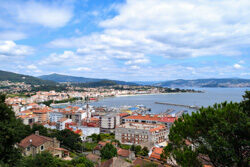Vigo, Galicia tourist information.
 Vigo is the capital of the province called Pontevedra, situated on the shores of the Atlantic Ocean in northwest Spanish region of Galicia. However not the capital of Galicia, making Vigo the largest city in Spain that is not a regional capital. Vigo is an important port town, and has the largest fishing port in Europe as well as one of the fastest growing cities. The port of Vigo, one of the finest natural ports in the world, was the origin of this city fringed by mountains. Its maritime qualities, already exploited in Roman times, have given rise to the present-day marinas and the transatlantic harbour, as well as to the fishing and canning industries. All of this has contributed to the urban development of Vigo, which includes the traditional port area and boasts major historic buildings and wide tree-lined avenues.
Vigo is the capital of the province called Pontevedra, situated on the shores of the Atlantic Ocean in northwest Spanish region of Galicia. However not the capital of Galicia, making Vigo the largest city in Spain that is not a regional capital. Vigo is an important port town, and has the largest fishing port in Europe as well as one of the fastest growing cities. The port of Vigo, one of the finest natural ports in the world, was the origin of this city fringed by mountains. Its maritime qualities, already exploited in Roman times, have given rise to the present-day marinas and the transatlantic harbour, as well as to the fishing and canning industries. All of this has contributed to the urban development of Vigo, which includes the traditional port area and boasts major historic buildings and wide tree-lined avenues.
The main attraction of Vigo is the coastline itself with numerous white, sandy beaches, many of which are Blue Flag accredited and connected by pretty coastal walking trails. The bustling port offers ferries to nearby towns like Cangas and Moana, and boat trips are available to the unspoilt Cies Isles, rugged islands with pristine beaches that form part of the National Park of the Atlantic and are home to thousands of migratory birds.
Things to do in Vigo
- The old historic centre of the city.
Based around the original fishermen’s houses and located on the slopes leading down to Vigo’s earliest port, the city’s old quarter is extremely underrated and actually a small treasure. - Atlantic Islands of Galicia National Park, including the Cíes Islands.
The Cíes Islands, located in the Vigo Estuary and part of the Atlantic Islands National Park, are a paradise of white sand beaches and clear waters. This is a stunning natural environment where you can enjoy hiking, diving, anchoring your boat or simply strolling by the sea. - The Port
The marina has a continuous promenade, offers an opportunity to see every type, size and value of boat imaginable and, on a sunny day, makes for a relaxing and enjoyable walk. The area is frequented with cafes and bars and is close to the old quarter of the town. - Museum of Contemporary Art.
Vigo Museum of Contempary Art (MARCO) opened to the public in 2002 and became one of the newest museums in Galicia. Located in the heart of the city’s commercial quarter, i.e.the pedestrian and centrally situated Principe Street, the museum occupies what was formerly Vigo’s Prison and Court (1880). - Co-Cathedral of Santa Maria de Vigo.
The Cathedral of Vigo, popularly known as La Colegiata, is one of the best examples of religious architecture in Vigo, an exponent of neoclassical art in Galicia and the city’s most important temple. Located in Vigo’s Old Town, it was built in 1811 over the remains of a previous church and commissioned from Melchor de Prado y Mariño. This basilica with three naves has a facade with simple ornamentation and a unique sundial on its right side, which curiously does not face south. The Church of Santa María houses the image of the Cristo de la Victoria, arguably Vigo’s most important religious emblem. - Church of Santiago de Bembrive.
- Church of San Salvador de Coruxo.
- Museum of Castrelos.
- Catch a football game at Balaídos Stadium, home of Celta de Vigo.
Galicia
Three major ports attest to Galicia’s close relationship with the sea. In the south is Vigo and in the north are La Coruña and the naval base of El Ferrol. Galicia was one of the central points for Western European Megalithic Culture, and physical remains are still visible today. Nonetheless, Galicians trace their cultural ancestry back to Celtic tribes which began to settle around 1000 BC. Celtic Civilisation in Galicia had its heyday between 600 and 25 BC, up to when Galicia fell under the power of the Roman Empire. Still, a weak Romanisation meant the consolidation of a hybrid culture, bearing strong Celtic traits.